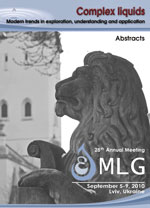Shear relaxation and ionic transport of imidazolium-based ionic liquids
Tsuyoshi Yamaguchi
We shall present our experimental and theoretical studies on the frequency-dependent shear viscosity and ionic mobilities of representative imidazolium-based ionic liquids.
On experimental side, we developed a shear impedance spectrometer based on QCM-D technology, which enables us to determine the complex shear viscosity from 5 to 205 MHz [1]. The shear impedance spectroscopy was then applied to four representative imidazolium-based ionic liquids, [Cnmim][PF6] with n = 4, 6, 8 and [C4mim][TFSA], where n stands for the length of alkyl chain. Comparing the shear relaxation spectra of [C4mim][PF6] at 283 and 298 K, the normalized spectra agree with each other when the frequency is shifted by multiplying the zero-frequency shear viscosity, which indicates that the increase in the relaxation time is the principal reason for the increase in the zero-frequency shear viscosity with decreasing temperature. The difference between the shear viscosities of [C4mim][PF6] and [C4mim][TFSA] is also explained by the relaxation time. On the other hand, the increase in the relaxation time with lengthening the alkyl chain of the cation is larger than that in the zero-frequency shear viscosity. In addition, the relaxation time distribution becomes broader with lengthening the alkyl chain. Comparing the shear relaxation spectrum with the frequency-dependent electric conductivity determined by dielectric spectroscopy, the relaxation of conductivity is faster than that of shear viscosity, indicating the partial decoupling between shear viscosity and electric conductivity.
On theoretical side, the dynamic properties of [C2mim]Cl were calculated at 400K with mode-coupling theory for molecular liquids based on the interaction-site model [2]. The static structure required as the input function is taken from an MD simulation. The theory captures the characteristics of the slow dynamics of the ionic liquid. In particular, the relaxations of shear viscosity and electric conductivity appear in 100 MHz region as have been observed in experiments. The theoretical analysis shows that the dielectric relaxation observed in 100 MHz region is mainly ascribed to the translational modes of ions, contrary to the conventional assignment of the reorientational relaxation of the cation. The relaxation of electric conductivity is faster than the shear relaxation as is observed in the experiment. The frequency-dependent self-diffusion coefficients of ions possess the relaxation time similar to the shear viscosity. Therefore, the decoupling between the shear viscosity and electric conductivity is ascribed to the correlation between the ionic motions.
References
- T. Yamaguchi, S. Miyake and S. Koda, J. Phys. Chem. B, in press (2010).
- T. Yamaguchi and S. Koda, J. Chem. Phys. 132 (2010) 114502.



